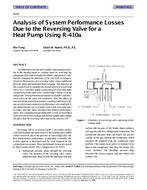Description
A traditional reversing valve enables a heat pump to operate in the heating mode or cooling mode by switching the refrigerant flow path through the indoor and outdoor coils, thereby changing the functions of the two heat exchangers. However, the presence of a reversing valve causes additional pressure drops and undesired heat exchange. The objective of this research was to measure the overall effects of a reversing valve on a 3-ton heat pump system using R-410a and make comparisons to the same valve’s performance with R-22 as the refrigerant. The experiments included tests of under- and oversized valves at the same test conditions. Also, the effects of pressure drops and of heat transfer combined with mass leakage on system and compressor performance were analyzed. It was found that the use of a larger (oversized) reversing valve to reduce pressure drops provided only limited performance gains. Also, changing refrigerant from R-22 to R-410a resulted in an increase in mass leakage but did not significantly change the effect that the reversing valve had on the system COP.
Units: Dual
Citation: ASHRAE Transactions, vol. 105, pt. 1
Product Details
- Published:
- 1999
- Number of Pages:
- 9
- File Size:
- 1 file , 460 KB
- Product Code(s):
- D-7522




